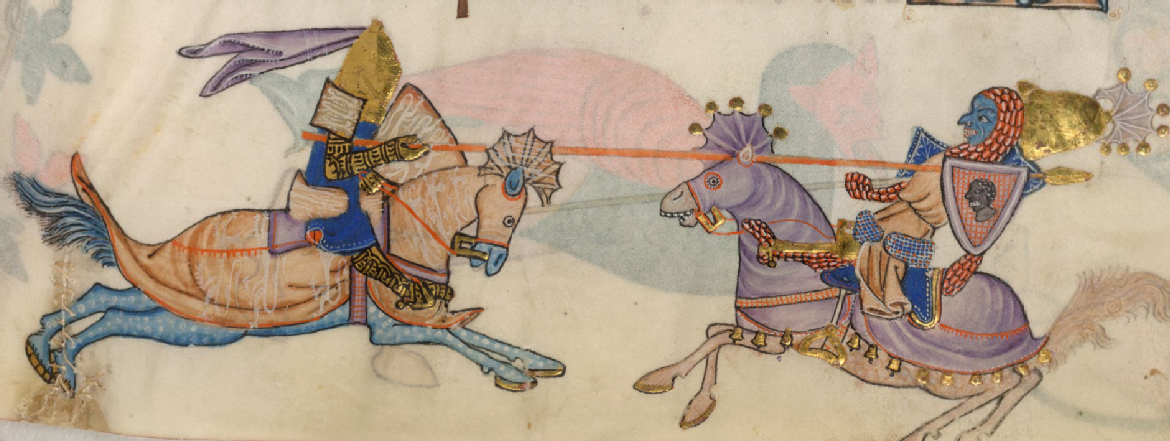EN398 Medieval Alterities: Race, Religion, and Orientalism in the Literature of Medieval England
This module is not currently running.
General Presentation
The Module will analyse the representations of ethnic, religious, and cultural difference found in literary and non-literary texts produced in England during the period 1250-1500. The main aim of the module is to allow students to develop a clear and nuanced understanding of medieval constructions of identity, with primary emphasis upon the identity of groups and communities. Three broad and overlapping categories and their intersections will be explored: Race; Religion; and Geographical/Cultural identity.
Rather than being concerned with historical realities as such, the module will largely be focusing on cultural perceptions, constructions, and fantasies of alterity. This will shed light on the primary categories invoked to define the identity of a recognisably Christian, Western European, and English community, primarily through narratives of conflict and/or encounter with various types of real or imagined historical ‘others’. The principal minority groups examined will be those of Muslims/Saracens; Jews; the ‘East’ more broadly; Vikings and Saxons; and the culture of Pagan Antiquity. The types of texts considered range from travel narratives to crusading romances, ‘historical’ accounts, plays, and some of Chaucer’s Canterbury Tales.
Learning Outcomes
• To familiarise students with some of the most important literary and non-literary genres involved in representing cultural difference during the late medieval period in England (1250–1500).
• To understand some of the most fundamental historical, religious, and cultural categories invoked in the construction of identity during the period. • To understand the role of fiction and imagination in shaping the Western perception of non-Christian and non-European cultural and religious practices as well as oriental geographical locations.
• To emphasise the importance of imaginative constructions, fictions, and fantasies in shaping the course of history.
• To familiarise students to the cultural and intellectual context of religious persecution and crusading during the late Middle Ages.
• To stress the role of narratives of violent conflict and warfare, as means of 1) constructing and/or consolidating binary identitarian models (‘them’ vs. ‘us’); 2) Interrogating and undermining this same binarism, and questioning the legitimacy of narratives of Western/Christian/European cultural superiority.
• To introduce students to the fundamental principles of medieval geography, ethnography, anthropology, history, and cosmology.
Syllabus
Pilgrimage, Exploration, and Orientalism:
Introduction and Module Themes: Powerpoint presentationLink opens in a new window
w1. Primary Text: Mandeville’s Travels
Context and Criticism:
- 'IntroductionLink opens in a new window' to Sylvia Tomasch and Sealy Gilles, eds, Text and Territory: The Geographical Imagination in the European Middle Ages (UPenn, 1998),
- Iain MacLeod Higgins, 'Defining the Earth's Centre in a Medieval Multi-text: Jerusalem in Mandeville's Travels'Link opens in a new window, in Text and Territory, ed. Tomasch and Gilles
- Suzanne Akbari, 'The Diversity of Mankind in The Book of Sir John Maneville'Link opens in a new window, from Eastward Bound: Travel and Travellers, 1050–1550, ed. Rosamund Allen (Manchester UP, 2004)
The Romance of England:
w2. Primary Texts: King Horn; Havelock the Dane
Context and Criticism:
- Diane Speed, 'The Saracens in King HornLink opens in a new window', Speculum 65.3 (1990), 564–95.
- Thomas Crofts and Robert Rouse, 'Middle English Romance and National Identity'Link opens in a new window, from Raluca Radulescu and Cory James Rushton, eds, A Companion to Medieval Popular Romance (Brewer, 2010)
w3. Primary Text: Bevis of Hampton
Context and Criticism:
- Robert Rouse, 'For King and Country? National vs. Regional Identity in Sir Bevis of HamptonLink opens in a new window', from Sir Bevis of Hampton in Literary Tradition, ed Jennifer Fellows and Ivana Djordjevic (Boydell, 2008).
Saracens and the East:
w4. Primary Text: Richard Coeur de Lion
Context and Criticism:
- Extracts from Debra Strickland, Saracens, Demons, and JewsLink opens in a new windowSaracens, Demons, and JewsLink opens in a new window: Making Monsters in Medieval Art (Princeton UP, 1998)
w5. Primary Text: The King of Tars
Context and Criticism:
- Extracts from Geraldine Heng, The Invention of Race in the European Middle Ages (Cambridge UP, 2018) : IntroductionLink opens in a new window ; Chapter 4: Color.Link opens in a new window
w6. READING WEEK
Judaism:
w7. Primary Text: The Siege of Jerusalem
Context and Criticism:
- Sylvia Schein, Gateway to the Heavenly City : Crusader Jerusalem and the Catholic West, 1099-1187 (Routledge, 2005 / 2016), pages 1–62. Ebook accessible here through Library.Link opens in a new window
w8. Primary Text: ‘Prioress’ Tale’ (Riverside Chaucer)
Context and Criticism:
- Sylvia Tomasch, 'Postcolonial Chaucer and the Virtual Jew'Link opens in a new window, from The Poscolonial Middle Ages, ed. JJ Cohen (Palgrave, 2000)
- Rachel Trubowitz, '"But Blood Whitened": Nursing Mothers and Others in Early Modern Britain'Link opens in a new window.
w9. Primary Text: Croxton Play of the Sacrament
Context and Criticism:
- Robert C. Stacey, 'From Ritual Crucifixion to Host Desecration: The Jews and the Body of ChristLink opens in a new window' Jewish History 12.1 (1998).
Pagan Antiquity:
w10. Primary Text: ‘Knight’s Tale’ (Riverside Chaucer)
- Extracts from A.J. Minnis, Chaucer and Pagan Antiquity (Boydell & Brewer, 1982)
Required reading: Introduction + chapter 2Link opens in a new window
Optional additional reading: chapter 4Link opens in a new window
Assessment
• 1 x 5000 word essay (100%), from a given choice of topics
• short in-class presentation (formative)
Required Primary Texts
NB - most texts are available online, and can be purchased as hard copies through the TEAMS website
- The Book of Jean Mandeville - online edition hereLink opens in a new window
- King Horn ; Havelock the Dane; Bevis of Hamptoun - online edition hereLink opens in a new window
- The King of Tars - online edition here
- Richard Coer de Lyon - online edition hereLink opens in a new window
- The Siege of Jerusalem - online edition hereLink opens in a new window
- The Riverside Chaucer
- The Croxton Play of the Sacrament - online edition hereLink opens in a new window

